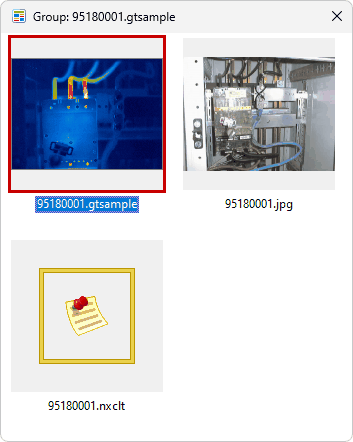Infrared image formats
Infrared image formats are designed by infrared cameras manufacturers, they all different and have different filename extensions.
Some infrared cameras produce images in a file formats designed to store only infrared image data and nothing else. When you manually connect a visual image to such raw infrared image in IRT Cronista, IRT Cronista renames the visual image file to mark that the two images are linked, so there are two files on the disk.
Another wide used method of saving infrared images is to store infrared data as extra data in a jpeg file. This allows to have image preview in a common format and to also keep infrared sensor data. Visible image can be stored in the same way - as an extra data in the same jpeg file.
When you add measurement objects to infrared images or modify some parameters like temperature range or palette, this data has to be saved somewhere as well. IRT Cronista stores this data in an additional file which has the same name as the infrared image but a different extension - nxclt.
The advantage of this approach is that the original infrared image data does not change and is stored in the form in which it was created by the thermal imager. The downside is that you end up with a bunch of files on disk which can be hard to manage.
To see all linked files and to have access to each of them individually, right-click on an infrared image and select Grouped Items from the context menu. In the dialog opened, you can see all the files connected to the selected infrared image.

Note: If there are no files linked to the selected infrared image (no notations and comments and no linked visual image), the menu command Grouped Items is not available. |
GTSI analyzed image format
GTSI is a GRAYESS proprietary file format that stores infrared image, linked visual image and analysis data in one file. When you connect a visual image to an infrared image in IRT Cronista, the visual image is written into the infrared image file. The analysis data is also saved in this file. It is very convenient, for example, when you want to e-mail this three-in-one file to somebody instead of sending all three separated files.
Things you should be aware of when keeping images in GTSI format:
1.Infrared image data is converted into a proprietary format. Image pixels and infrared parameters are kept unchanged, measurements will be as accurate and as functional as for the original format. At the same time, original infrared image file may store some additional data known and used only by the internal software of the camera - this kind of data may be lost during conversion to GTSI. Because of this we recommend always to keep images backup copy in the original format.
2.Visual images are converted to jpeg when stored in GTSI files (quality loss may occur); in some cases they may be reduced in dimensions (IRT Cronista will warn you then).
To convert infrared images to GTSI format: 1.Switch to the Organizer mode. 2.Select the images you want to convert. 3.Right-click on one of the selected images and choose Convert to GTSI from the context menu. 4.Follow the instructions on the screen: you can overwrite the original file or keep GTSI files in a special folder/subfolder (recommended). |


